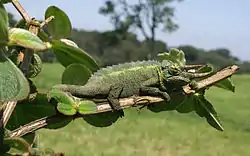mũriyũ
Kikuyu
Alternative forms
- mũriiũ
Pronunciation
- IPA(key): /mòɾìːǒ/
- As for Tonal Class, Benson (1964) classifies this term into Class 2 with a disyllabic stem, together with kĩgunyũ, njagĩ, kiugũ, and so on.
- (Kiambu)
- (Limuru) As for Tonal Class, Yukawa (1981) classifies this term into a group including gĩkwa (pl. ikwa), ithangũ (pl. mathangũ), kiugũ, kĩboko, kĩgunyũ, kĩnya, kĩroboto, kĩrũũmi, mbogo, mũcinga, mũgate, mũhaka, mũrangi, mũrũthi, ndaraca, ndirica, njohi, nyũmba, thĩ, and so on.[1]
Noun
mũriyũ class 3 (plural mĩriyũ)
- three-horned chameleon[2][3]
Usage notes

Trioceros jacksonii
Near Nairobi, where Kikuyu people have lived, Jackson's chameleon (Trioceros jacksonii, syn. Chamaeleo jacksonii), especially T. j. jacksonii (syn. C. j. jacksonii) has been observed.[4]
See also
- kĩĩmbu
References
- Yukawa, Yasutoshi (1981). "A Tentative Tonal Analysis of Kikuyu Nouns: A Study of Limuru Dialect." In Journal of Asian and African Studies, No. 22, 75–123.
- “mũriyũ” in Benson, T.G. (1964). Kikuyu-English dictionary, p. 394. Oxford: Clarendon Press.
- Leakey, L. S. B. (1977). The Southern Kikuyu before 1903, v. I, p. 460. →ISBN
- Trioceros jacksonii (The Reptile Database). (retrieved 29 March 2018)
Further reading
- Fergusson, Gary and James Murphy and Richard Hudson (1990). "The quest for the Mount Kenya Muriyu." The Vivarium 3(1): 18–38.